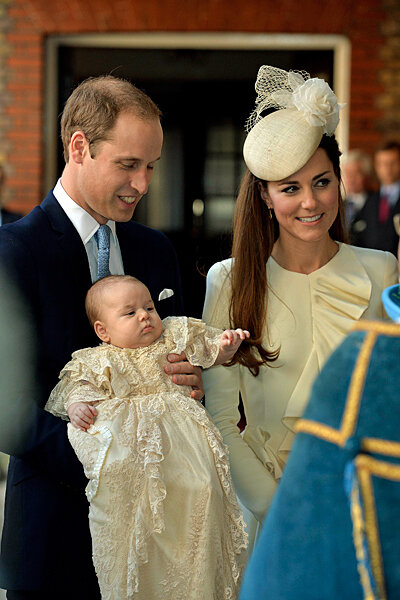Prince George's baptism hints at humbler era for British royals
Loading...
| London
The baptism of Prince George in London Wednesday is an undeniably historic event: the first step in a journey that is likely to see the three-month-old baby one day become Britain's monarch and titular head of the Church of England.
Despite the royalists gathered in the rain and the media scrum, the baptism does not have the air of a majestic state occasion. Instead, it is relatively low key and intimate, in keeping with what is emerging as the style of the Duke and Duchess of Cambridge, otherwise known as William and Kate: informal, unbound by tradition and wherever possible, a little bit normal.
“They are reinforcing the idea here that the royal family is changing,” says Alan Bright, editor of Royal Life, a magazine. “They understand people, more than pomp and ceremony, want a family they can identify with. And William and Kate just are more normal.”
Most royal baptisms have taken place in the splendid music room at Buckingham Palace, with European royals on the guest list.
But in a break with tradition, today's event is taking place in the Chapel Royal. Located in the grounds of St James's Palace, the venue is as small as its name suggests, with room for up to 60 people. Many members of the royal family have been left off the guest list to make space for close friends.
The only senior members of the royal family attending, besides the baby and his parents, are Queen Elizabeth and her husband, the Duke of Edinburgh; the Prince of Wales and his wife, the Duchess of Cornwall; and Prince Harry, William's brother.
Tradition too
St James's Palace has strong associations for the Duke and Duchess of Cambridge. It is where Kate was confirmed into the Church of England before her marriage. It is also where the coffin of Princess Diana was placed before her funeral.
The ceremony does not lack tradition. Prince George is being baptized by the Archbishop of Canterbury, Justin Welby, in a silver font made for Queen Victoria's firstborn, using water from the River Jordan in Egypt. He will be dressed in a replica of the lace and satin robe that 60 royal babies and future monarchs have worn since Edward VII. The archbishop is the top religious leader for the Church of England.
For royal watchers, the relative normality of the event is more striking than the ritual.
From the moment Kate stood outside hospital in July holding her hours-old baby, there were signs of a desire to live a more grounded existence. Many observers pointed out that she had not hidden her post-partum bump under a coat. The only subsequent photographs published of George have been taken by his grandfather, Michael Middleton.
This way of doing things – which royal pundits say is being carefully orchestrated by a team of advisers – seems to be having the desired effect.
The royal family is currently more popular than it has been in years. In a poll last year of 1,002 people, 69 percent said Britain would be worse off without the monarchy, and only 22 percent said the country would be better off.
New oversight
Nonetheless, changes must be made. Last week, Parliament's public accounts committee questioned Sir Alan Reid, the queen’s treasurer over a £2.3 million ($3.7 million) overspend in the past year. The questions were partly asked because, since 2012, Parliament has new oversight on how the royal family spends its money.
But there is also a growing awareness that a large, apparently spendthrift royal family is increasingly out of step with the mores of modern society.
“Some people still think that the royal family is far too big and spends too much money,” Mr. Bright says. “But as times goes by you'll get a royal family that is much more in sync with what people want.”
Ingrid Seward, the editor of Majesty Magazine, says the royal family itself believes that it should present a leaner image to the world.
“Prince Charles feel very strongly that people like Beatrice and Eugenie, though they are the queen's grandchildren, shouldn't be romping all over Europe under police protection,” she says. “The royal family will definitely be pared down to the core members as time goes by.”
Belt-tightening
Other changes have already been made to trim expenses. The queen now pays tax on her private income and the royal yacht has been decommissioned. The royal train will probably go the same way before long, according to Mr. Reid, who suggested it would be too expensive to replace when it runs out of steam in a few years.
Princess Michael of Kent told a newspaper recently she had been forced to sell her country estate after Parliament insisted the £69 ($111) weekly rent deal on her Kensington Palace apartment had to come to an end: “the worst thing I'd heard in ages," she was quoted as saying.
What happens to the royal family's massive property portfolio is less clear. The parliamentary committee highlighted that the royal palaces need some work. Parts of Buckingham Palace have not been touched since before Queen Elizabeth's coronation in 1953, its electrical system is believed to date from the 1940s, and a a 60-year-old boiler that needs replacing is producing rocketing energy bills.
But Ms. Seward points out that buildings need to maintained by someone. Taking them from the royal family will merely pass that buck, she says. And in the end, the British public does want its royal family to be just that: royal.
“They wanted to keep things private and intimate,” says Robert Jobson, author of the book "The New Royal Family," referring to the baptism. “But now they have a very difficult balancing act ahead of them. Because the shouts for photo shoots with Prince George are going to get louder and louder.”







